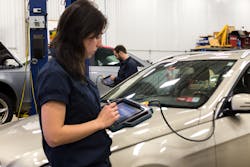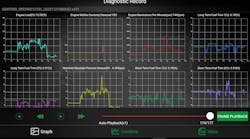Information is a key topic of discussion at just about any roundtable regarding automotive repair. Sure, there is always the usual “can’t find enough qualified technicians,” but all in all, what makes a qualified technician qualified? It’s the ability to utilize important information.
As with many different skilled trades, becoming good at your profession requires dedication and training in every aspect of the job, as well as a lot of practice, refresher courses, an abundance of reference materials, good observational skills, and the right tools.
When it comes to tools in our industry, there seems to be some disconnect between reference materials and the tools we use every day. Don’t get me wrong, when it comes to good vehicle repair information, there are many sources available. For the most part, with very little practice most technicians are good at obtaining the correct information to diagnose and repair vehicles properly and efficiently.
However, when it comes to operating instructions on our tools, information seems to be somewhat thin, especially on one of our most used pieces of equipment, our scan tools. If you utilize factory (OE) scan tools, most manufacturers have built the tools for the dealership network where technicians that use them have been trained specifically on their use.
If you are an independent aftermarket shop or a technician that does not have a dealership background, you may find there are limited reference manuals for the operation of those scan tools. This lack of information can sometimes make it difficult to diagnose and repair vehicles efficiently. In some cases, it may be worth considering an OE scan tool in addition to the more universal aftermarket ones, if for example, a specific vehicle make comprises 20 percent or more of the vehicles that come to your shop. Of course, you still need to evaluate the cost of the tool, training, and annual updates associated with an OE scan tool in order to calculate the ROI, especially considering it will only be used for one vehicle make, whereas an aftermarket scan tool can often be used for many.
Many of us probably have more than one manufacturer that reaches the 20 percent threshold and will require more than one OE tool, anyway. We also have a lot of other vehicles that would require a good aftermarket scan tool. Now we have another issue: some technicians are familiar and very proficient with a particular scan tool, but not as comfortable nor as effective with another. Some of this is easily overcome by training on the tool, while some of it is a little more difficult to cure due to differences in how aftermarket tools are programmed and supported.
In order to understand some of the issues, you need to appreciate the challenges scan tool manufacturers face. Almost every vehicle manufacturer has specific names for PIDS, modules, and bi-directional processes that are unique to their vehicles. When using an OE tool, the PID names and functions are consistent with the OE repair information – even more so if you have been trained on the information and use of the tool.
Because every vehicle manufacturer has their own “language,” it can be difficult for aftermarket scan tool manufacturers to integrate some tasks and information into an easy-to-use format for the technician. Additional challenges arise when the technician is forced to acquire repair information from an aftermarket source and use a scan tool, neither of which may be using terminology that is consistent with each other or the vehicle manufacturer.
Many aftermarket scan tools have renamed the OE specific module/PID/bidirectional terms into a more generic terminology that they use for every vehicle their scan tool supports. This makes it much easier for technicians to use the tool and learn to become efficient with it.
Aftermarket vehicle information sources do much the same thing, make information more usable by naming procedures and tests similarly across vehicle lines to make it easier for technicians to find necessary information quickly, rather than to try to find manufacturer-specific terminology.
When testing a vehicle with a scan tool, these challenges can cause diagnostic errors. Even though your scan tool is showing a perfectly good test result for a particular component or system, the readings may be in a different form, or in a lot of instances, not even close to what the repair information shows.
You might have to discern whether your scan tool’s software doesn’t align with the repair information or if you are misinterpreting the information. Some tool manufacturers are aware of this concern. I asked Danijela Haskin, product manager for diagnostics at Bosch, about this discrepancy.
“Bosch licenses data directly from the OEMs and develops other coverage to compliment OE service procedures," she says. "As an example, this is why you’ll find Bosch diagnostic tools use the same module system names, rather than putting them in generic terms. This helps when referencing OE information.”
Information and test results allow a technician to pinpoint the problems faster and easier than they could without such data. Having that information is the key to a successful diagnosis.
“The features available on our tools are those specific to that electronic control module for that particular manufacturer you’re working with and are not necessarily relatable to a similar engine from a different manufacturer,” says Bruno Gattamorta, vice president of diagnostic sales for Cojali USA. “Our tool is developed based on OEM standards, meaning that if the OEM proceeds in a certain way to achieve its tests and results, we will provide the same.”
“We match the OE service procedure found in most repair information sources,” says Michael Flink, commercial sales manager and trainer, North America, at Autel. “The intent is both to give better overall coverage and to make it easier for the technician to follow an OE service procedure. Autel also updates throughout the year, allowing it to keep up with those changes from the OEs.”
The good technician
This is where the ingenuity of a good technician shines best: That is, taking the raw data offered in the repair manual or scan tool and somehow converting it into useable data that conforms to the tools available. A lot of times, it’s a simple matter of converting newton meters to pounds per square inch or Celsius to Fahrenheit. Other times, it’s a game of wits between the technician and the repair information. But, adapting the scan tool and repair data into useable information combined with solid diagnostic procedures is the key to successful repairs.
A long time ago, I adopted a policy in my shop where any type of diagnosis had to be verified by performing the diagnostics using two entirely different methods and cross-checking the results between the two procedures. One method could be a scan tool, while the second method could be a multimeter. If the test results were verified by the results of the previous test, the job was a go.
This not only ensured a more accurate diagnosis but also gave the technicians a chance to explore new and innovative testing methods they may not have been as familiar with. For the most part, it avoided the dreaded comebacks and the ever-annoying (and present) technician dilemma of the “well, that isn’t it” scenario.
Scan tools: What is the technician looking for in a tool?
The number one thing I look for in a scan tool is coverage. First, a scan tool needs to have the coverage for the type of vehicle I’m most typically going to be working on, with access to as many forms of the tests and bidirectional controls similar to the factory tool, if not better. Good coverage for a few other manufacturers’ vehicles on the same scan tool is a plus. This avoids having to relearn different terminology and computer pages that are likely to differ from one manufacturer to another.
Graphing and pinpointing sensor data is a great feature, too, especially when it is easy to use and understand. Whether using a factory or aftermarket tool, it comes down to cost, updates, and the number of years covered by that manufacturer.
Things like data speed and touchscreen resolution come to mind as additional concerns, as technicians don’t always work in ideal lighting conditions. Autel’s Flink had this to say on features and functionality:
“Because Autel does not make an OE tool, our primary customer is the independent technician and shop. We engineer and test our tools to provide functionality beyond the standard releases. This does require extra work and cost in engineering to accomplish. Since Autel only makes diagnostic equipment, our vast engineering teams are focused on developing just that.”
Also consider adequate test leads, a sturdy hanger for the scan tool, and an adjustable volume level. Cord connections can be a problem, too. The weak point is often where the connection and the wire bundle meet. Although, cords are getting to be a thing of the past with the advent of the wireless dongle between the scan tool and the assembly line diagnostic link (ALDL). Now the only problem is not forgetting to remove the dongle before the car drives off.
Updates
Updates, updates, updates. This may be the biggest consideration of all. It’s the downtime that is the real issue. The fact that some scan tools will display a message such as “Erasing old data” before they begin downloading the new data is a bit unnerving as well.
Some manufacturers, such as Ford, will provide the dates of the next projected updates for their scan tools so you have the option to schedule scan tool downtime. I don’t believe there is ever a good time for downtime in a busy shop, but it’s essential to update these tools on time, nonetheless.
Final thoughts
With all this going on, there is still one aspect of the topic that needs a closer look. That is how to hook up the tool leads, the locations of the sensor, and the pin locations for the component you are trying to obtain the information about. Some manufacturers do a great job of providing drawings and directions for tool connections, but it is still one of the most frequently asked questions.
The novice or new apprentice/technician might not have paid attention to the initial process of hooking up the scope or scan tool, as they were far more interested in the results. When it’s time to try it for themselves, they are left standing there holding the test leads and wondering what to do next.
The key is to keep honing your skills every day. This business of car repair is based on ever changing and advancing technologies. All this automotive intel can only increase a technician’s knowledge base as well as their ability to adapt to the latest technologies coming from various manufacturers.
The vehicles are better and so are the technicians. It would be great if every time you picked up a scan tool or looked up repair information, the answers would pour out with no effort at all. Well, you know that’ll never happen. This job isn't that simple, it never was, and it still takes a dedicated technician to answer the call of the next problem and the next solution. Happy scanning!


